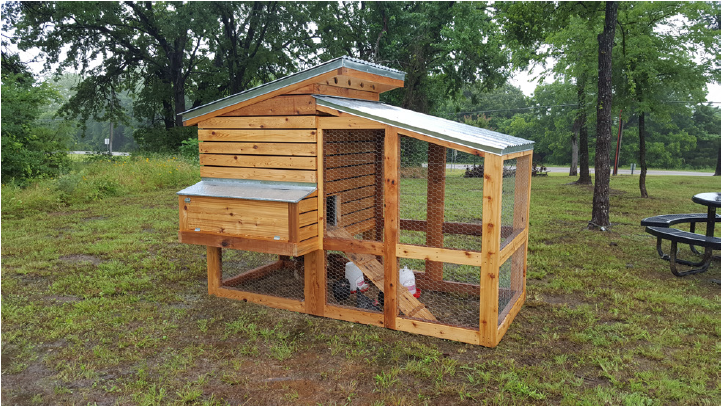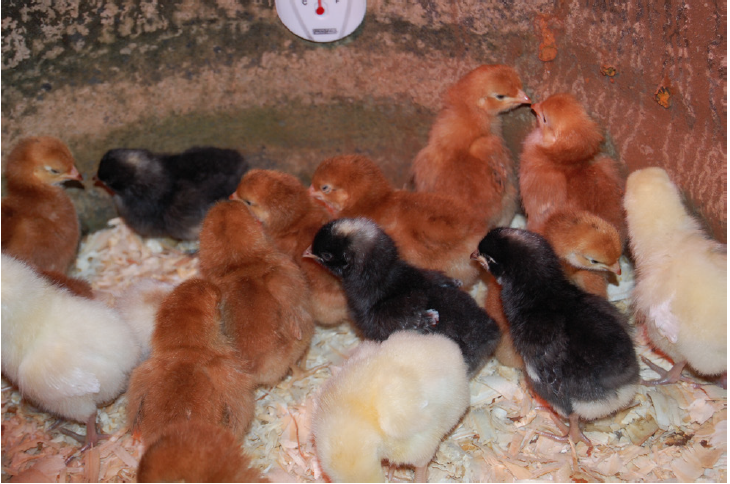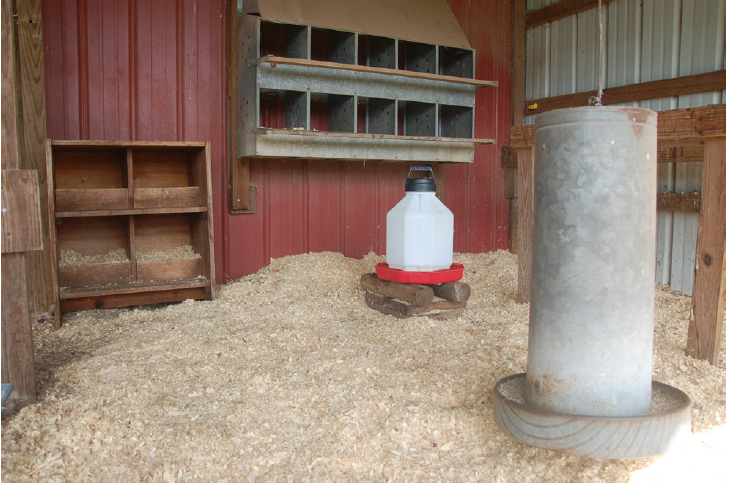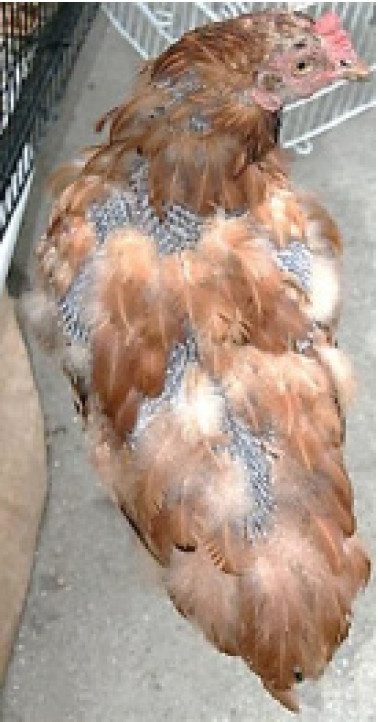Backyard Flock Production
Although the major supply of poultry meat and eggs in the U.S. is produced by commercial
farms, many people prefer to raise their own. A variety of reasons can be given for
home production, not the least of which is the desire to care for and be around growing
animals. Chickens can be raised in a small area and require a minimum amount of daily
care. However, anyone considering backyard flock production must look at a variety
of components before arriving at a decision. Learn more about protecting and managing
poultry from the OSU Extension Backyard Chickens course.
- Are there city ordinance or homeowner association restrictions that preclude the raising of poultry in the location being considered?
- Is there a source of feed available for growing the type of chickens being considered (commercial ration, certified organic, etc.)?
- Is the time or manpower available to maintain the premises so the chickens will not become a nuisance to the neighbors? Who will look after birds during a family vacation?
- Is suitable housing available for the flock being considered?
- If you plan to use your new flock as a source of income, is there a market for the product (i.e. can eggs and chick- ens be sold in the area)?
- Are facilities available for processing the product (i.e. picking and dressing the broilers or hens at the end of their productive period)?
- Are options available for disposing of normal mortality within the flock? For information on poultry mortality disposal refer to Extension Fact Sheet AFS-8219, Proper Disposal of Routine and Catastrophic Livestock and Poultry Mortality.
Housing
The first requirement in any poultry enterprise is to have adequate housing to provide protection from heat, cold, inclement weather and predators. A dry, draft-free house with ventilation is essential to the health and well-being of every bird. In the summer, ventilation provides a way to keep the interior temperature at a comfortable level. Ventilation in the winter is also necessary, not only to provide fresh air to the house, but also to remove moisture as an aid in the maintenance of dry litter. For small coops, windows or vents on one or two sides of the house usually provide plenty of ventilation. Windows or vents should be placed on sides away from prevailing winter winds; the south or east side is best.
In some cases, there may be buildings on the property that can be altered or renovated for the poultry enterprise with a minimum expense. Depending on bird size, space requirements for laying hens will be 1.5 to 2 square feet per bird inside the house. Broilers need slightly less room at 1 square foot per bird.
The type of construction does not need to be elaborate or highly sophisticated. However, some backyard producers with limited space prefer pre-designed coops, such as the one shown below.
The poultry house can be used throughout the entire life-span of the chickens. For the producer who intends to keep chickens for egg production, but intends to start each new flock with day-old chicks, two houses will be necessary. Separate housing is needed because it is not recommended that birds of significantly different ages be housed together. This is important from a disease standpoint and because different ages require different temperatures, feed and space. To maintain continuous production, the producer may want to purchase started pullets. These are birds approximately 20 weeks old and will start producing eggs soon after being placed in the house.
For those desiring to keep their chickens confined, a run will be necessary to provide sunlight and exercise for the birds. When developing housing for a backyard flock, be sure to construct the poultry coop and runs in a manner that protects birds from invading predators. Depending on bird size, space requirements will be 8 to 10 feet per bird in the run.

Photo courtesy: Josh Payne
Breed Selection
The chickens available today have been genetically bred for specific purposes. For example, meat birds have been bred for increased breast yield and improved feed conversion rates. They usually will not lay enough eggs to make it economically feasible to keep them beyond the broiler-fryer age. Likewise, layers have been bred for increased egg production and smaller bodies. They will not grow rapidly enough to make good meat producers. There are some “dual purpose” breeds available. With these breeds, it is sometimes desirable to slaughter the males for food and keep the females for egg production. The breed should be selected for the purpose desired. Most hatcheries can determine the sex of day-old chicks and will separate males from females, if requested.
Baby Chicks
Purchasing baby chicks from a hatchery is an excellent method of obtaining birds for either meat or egg production. Whether buying chicks from a local hatchery or ordering through an on-line hatchery, it is important to plan and order chicks well in advance to ensure getting the desired number and kind of birds. Purchasing chicks from a hatchery that participates in the National Poultry Improvement Plan (NPIP) will ensure that the birds have tested clean of certain diseases or have been produced under disease prevention conditions. Additionally, chicks can be purchased from various farm supply stores. Often, there will be options to purchase straight-run chickens or pullets. Straight-run refers to “just as hatched” and will result in approximately 50 percent females and 50 percent males.
Brooding
From the time the baby chick is a day old until it reaches about six weeks of age, some supplemental heat may be necessary for optimum growth. This will depend on the environmental temperature. For the first week, the chicks should be kept at about 90 to 95 F. The temperature may be lowered 5 F each week until a temperature of 70 F is reached. Thereafter, supplemental heat may be necessary only if the outside temperature is extremely cold. The chicks’ behavior is the best indicator of appropriate temperature in the brooder. Chicks scattered throughout the brooding area giving a contented sound are comfortable. Huddled, peeping chicks need additional heat, while those panting with their mouths open need cooler temperatures. Even though the chicks provide an idea about temperature, a small thermometer at chick level is very useful. Supplemental heat may be provided from heat lamps or brooder stoves fueled by gas or electricity.
Plenty of feed and fresh water must be available to the baby chicks as soon as they arrive from the hatchery. A good start gives a better chance at successful production in the future.

Photo courtesy: Josh Payne
Feed and Water
Rations are scientifically formulated for specific purposes. The starter ration is quite similar whether for broilers or egg production stock. However, grower rations for broilers will be quite different from the grower rations for egg-laying stock. Specific recommendations are available for each ration type and should be followed closely for best results. Feed costs make up the majority of expenses in raising birds, so producers should ask questions about available feed options. It is best to use complete feeds not requiring supplementation with other ingredients. If grains or other feed materials are relied on, an imbalance of nutrients may cause mineral or vitamin deficiencies, resulting in reduced growth, production or adverse health effects. It is recommended that scratch, grains and kitchen scraps be provided at no more than 10 percent of the daily diet. For a mature hen that consumes only 0.25 pound of feed each day, this will be a very small amount.
When the baby chicks are first placed in the house, the feeders should be well filled, but after birds have learned to eat, the feeders should be no more than three-fourths full to prevent waste. There should be enough feeder space avail- able for all chickens to eat at the same time for most efficient production. It is desirable to clean the feeders frequently, since mold and fungus may develop on the equipment and impact bird health.
Fresh, clean water is necessary for the efficient production of meat or eggs by the chicken. The first waterers used by baby chicks can be a jar lid and should be cleaned often. As the chicks get older or for the laying hens, troughs or automatic flow fountains can be utilized. Whatever type of equipment is used for watering, it should be placed so the chickens cannot contaminate the water with their feet.
Feeders and waterers adequate for the small flock can be of home construction or may be purchased from a farm supply store. Both types of equipment need the capability of height adjustment as the chickens grow. If using hanging feeders or automatic flow fountains, they may simply be elevated higher off the ground. Nipple watering systems are becoming more popular among backyard flock producers due to reduced labor. If using nipple drinkers, the bottom of the triggering pin should be at eye level for day-old chicks. Nipple drinker height should be raised over time, so the birds must reach up and stretch slightly to activate the nipples. Any watering system should be constructed of material that can be cleaned and disinfected regularly to prevent the buildup of biofilms, which can harbor harmful bacteria and viruses.

Photo courtesy: Josh Payne

Photo courtesy: Todd Johnson
Lights
Commercial broiler operations often have lights on during the hours of darkness so the birds have approximately 24 hours of light each day. For the home flock owner, this will increase the cost of production. Although maximum efficiency may not be attained, 12 to 14 of hours of light per day should be sufficient. If lights are left on at all times, at least 15 minutes of darkness should be planned. This allows birds to become accustomed to darkness and avoid a panic if the power is interrupted.
A similar situation will exist in the egg production flock. The reproductive system in hens is stimulated by increasing day length beginning in spring. As day length approaches 14 hours per day, hens begin to lay eggs. This allows for chicks to hatch in the spring and grow in the warmer summer months before winter arrives. As fall approaches and day length shortens, egg production declines until spring. Providing artificial light can allow for hens to continue to produce eggs year-round. Maximum production efficiency will occur at approximately 16 hours of light per day. Artificial light should be applied when day length is reduced to around 15 hours per day, which usually occurs in early fall. A timer can be used to supplement light in the morning, allowing birds to naturally go to roost at sunset. Artificial light should not be introduced to pullets until they reach maturity, around 18 weeks of age. Introduction of artificial light too early can stimulate the reproductive cycle before the bird is ready to lay.
Equipment and Bedding
For the backyard flock owner, equipment does not need to be sophisticated. The broiler flock needs only feeders and waterers for adequate growth. Nesting facilities need to be added for the egg-producing flock. Layers prefer perches to roost and escape pecking from dominate hens. Whether the floor is dirt, wood or concrete, bedding material is a necessity for either broilers or laying hens. This bedding material should be absorbent to keep the conditions within the house dry and comfortable for the chickens. Wood shavings, peanut hulls, rice hulls or other commercial bedding material are all satisfactory. The litter should be stirred frequently to encourage drying and prevent matting or caking. If the litter gets wet at any time, the wet portion should be removed and new bedding returned in its place. Wet litter is an excellent media for disease organism growth and can affect the health and production of the flock.
Disease and Parasites
A well-fed flock housed in comfortable conditions will have a minimum of disease and parasite issues. If purchasing from a hatchery, baby chicks can be vaccinated for common poultry diseases. The supplier will know whether this has been done or can arrange to have it done prior to delivery.
Sanitation is still the best known prevention of disease and parasites. Cleaning the house thoroughly between groups of chickens, maintaining dry litter and providing sufficient floor space for the birds will prevent many of the disease, parasite and cannibalism problems that could be encountered in a poultry flock.
If problems develop, treat on an individual basis. Each condition needs to be specifically examined for accurate diagnosis and control recommendation. If the flock owner will contact the supplier of the chicks, the representative of the feed company or the local Extension office, qualified personnel can be obtained for help on poultry problems. Many of the medications for disease control and the drugs for parasite control are not only specific for certain conditions, but also are subject to changing regulations. For example, beginning January 1, 2017, some of the common over-the-counter drugs purchased for livestock and poultry will require a veterinary feed directive order issued by a licensed veterinarian. For more information refer to Extension Fact Sheet VTMD-9136, Veterinary Feed Directive.
Processing Broilers
Broilers will be ready to eat or put in the freezer at about seven weeks of age. If the birds are processed at home, is it desirable to process only a few birds each day to avoid fatigue. Considerable labor is involved in preparing the broilers for the freezer and it can become discouraging if too many are done at one time. Feed should be withdrawn 12 hours prior to processing to allow the feed to pass through the bird and reduce carcass contamination risks.
Many communities do not have facilities available for custom processing, so individual producers may need to be ready to process their own birds. Sanitation of equipment is of paramount importance during the processing operation, as the conditions are quite suitable for bacteria growth. The bird should be hung by the feet before cutting the throat at the base of the jaw.
After bleeding for one or two minutes, the bird should be immersed in 130 F to 135 F water for 30 to 75 seconds to loosen the feathers for easy removal. This temperature is somewhat critical, as a high temperature will cook the skin and cause it to tear easily, while water that is too cold will not relax the muscles adequately, making the bird hard to defeather. After the feathers, head, feet and internal organs have been removed, the carcass should be washed thoroughly with clean water and placed in an ice water bath to chill the carcass to 40 F. Chilled carcasses can then be hung to drain, followed by packaging. Packaged carcasses should then either be properly refrigerated or frozen.
Processing should be done in a location that can be easily cleaned, because blood and feathers left unattended can result in fly and odor problems. Provisions will also need to be made for proper disposal of the offal from the processing operation. Composting is probably the most satisfactory method of disposal. For more information, refer to Extension Fact Sheet AFS-8220, On-farm Mortality Composting of Livestock Carcasses.
Producers processing more than 250 turkeys or 1,000 chickens per calendar year for
direct sales to in-state household consumers must apply for state inspection through
the Oklahoma Department of Agriculture, Food and Forestry (405) 522-6119.
Producing Eggs
Successful egg production will probably depend on the correct feeding and lighting programs as well as good management of the layers. Nests located in a dark portion of the house should be provided. One nest for each four layers should be adequate.
Eggs should be stored in a refrigerator as soon as gathered. Any dirty eggs should be scraped clean or sanded with a block of wood covered with sandpaper before being placed in the refrigerator. Material on the eggs will contain bacteria, and although the egg shell and membranes do not allow easy passage into the egg, the shell is porous and some penetration will result from continued exposure. If washed, eggs should be washed in water that is warmer than the eggs. This is so the egg contents expand and push away invading bacteria from the egg pores. Excessively dirty eggs should be discarded. Frequent replacement of bedding in the nests will keep the production of dirty eggs at a minimum.
Producers that sell eggs off-farm must obtain an annual license, grade eggs and register with the Oklahoma Department of Agriculture, Food and Forestry.
Molting
Molting is a natural process chickens go through each year that allows egg production, shell thickness and quality to improve during the chickens next egg cycle. During molting, the chicken will go through both internal and external physiological changes. The reproductive tract will regress and go into a period of rest. Chickens will lose weight due to some loss of body fat, liver tissues and musculature and skeletal mass. Loss of old feathers and the growth of new will also occur. Typically, egg production will slow and may even stop until the molt is complete.
Chickens will either be late molters or early molters. Late molters lay for 12 to 14 months before molting, whereas early molters may begin their first molt after only a few months of production. Generally, the better-producing late molters will have a more ragged appearance. This is due to the short duration of their molt (two to three months) along with the loss and regrowth of feathers during this time. Early molters will molt for a longer duration (four to six months), losing one or two feathers at a time. Early molters will have a smoother, better groomed appearance, but will not be as productive during their lifetime.

Photo courtesy: USDA
Economics of Backyard Flock Production
In many cases, the cost of eggs or meat produced will cost more than the purchase price in a retail store. This will be particularly true if any charge is assessed for home labor. For good production, a chicken must be well fed and well managed. The raising of chickens can be a satisfying experience, as well as a source of fresh, highly nutritious food items for the family table.
Dana Zook
Area Livestock Specialist
Josh Payne
Adjunct Associate Professor
